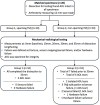Analysis of Trapeziometacarpal Joint Mechanics During Spanning and Nonspanning Fixation for Thumb Metacarpal Distraction Lengthening
- PMID: 40223408
- PMCID: PMC11996813
- DOI: 10.1177/15589447251322916
Analysis of Trapeziometacarpal Joint Mechanics During Spanning and Nonspanning Fixation for Thumb Metacarpal Distraction Lengthening
Abstract
Background: Thumb trapeziometacarpal joint (TMj) contact area, pressures, and stability were quantified during metacarpal osteotomy and distraction lengthening with and without TMj-spanning fixation in a cadaver model. Spanning fixation was hypothesized to decrease TMj contact pressure, contact area, joint space narrowing, and subluxation compared with metacarpal fixation alone.
Methods: Twenty matched-paired cadaver specimens underwent ligament-sparing thumb TMj dissection. A metacarpal external fixator was applied with and without a TMj-spanning component in 2 groups: spanning and nonspanning. A diaphyseal osteotomy was performed. The TMj contact pressure and area were recorded with an intraarticular sensor at baseline and at distraction intervals of 10, 20, 30, and 35 mm. The number of overloaded sensor cells (sensels), (>2000 psi) were recorded. The TMj subluxation and joint space width were assessed at all intervals with lateral thumb radiographs. Statistical analysis used paired 2-tailed t tests to account for inherent specimen characteristics.
Results: Group 1 (TMj-spanning) exhibited a nonstatistically significant reduction in contact area and demonstrated fewer overloaded sensels. There was significantly less joint space narrowing and joint subluxation from 10 to 30 mm of distraction compared with group 2 (nonspanning).
Conclusions: The TMj spanning fixation during metacarpal distraction decreased joint space narrowing and TMj subluxation. Despite finding reduced contact area and fewer overloaded sensels in group 1, these parameters did not reach statistical significance. Spanning TMj fixation may mitigate TMj instability during metacarpal distraction osteogenesis.
Keywords: carpometacarpal; distraction lengthening; osteotomy; pressure sensors; thumb amputation; thumb metacarpal.
Conflict of interest statement
The authors declared no potential conflicts of interest with respect to the research, authorship, and/or publication of this article.
The author(s) declared no potential conflicts of interest with respect to the research, authorship, and/or publication of this article.
Figures




References
-
- Beasley RW. Surgery of hand and finger amputations. Orthop Clin North Am. 1981;12(4):763-803. - PubMed
LinkOut - more resources
Full Text Sources

